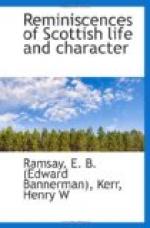The old Scottish hearers were very particular on the subject of their minister’s preaching old sermons; and to repeat a discourse which they could recollect was always made a subject of animadversion by those who heard it. A beadle, who was a good deal of a wit in his way, gave a sly hit in his pretended defence of his minister on the question. As they were proceeding from church, the minister observed the beadle had been laughing as if he had triumphed over some of the parishioners with whom he had been in conversation. On asking the cause of this, he received for answer, “Dod, sir, they were saying ye had preached an auld sermon to-day, but I tackled them, for I tauld them it was no an auld sermon, for the minister had preached it no sax months syne.”
I remember the minister of Banchory, Mr. Gregory, availed himself of the feelings of his people on this subject for the purpose of accomplishing a particular object. During the building of the new church the service had to be performed in a schoolroom, which did not nearly hold the congregation. The object was to get part of the parish to attend in the morning, and part in the afternoon. Mr. Gregory prevented those who had attended in the morning from returning in the afternoon by just giving them, as he said, “cauld kail het again.”
It is somewhat remarkable, however, that, notwithstanding this feeling in the matter of a repetition of old sermons, there was amongst a large class of Scottish preachers of a former day such a sameness of subject as really sometimes made it difficult to distinguish the discourse of one Sunday from amongst others. These were entirely doctrinal, and however they might commence, after the opening or introduction hearers were certain to find the preacher falling gradually into the old channel. The fall of man in Adam, his restoration in Christ, justification by faith, and the terms of the new covenant, formed the staple of each sermon, and without which it was not in fact reckoned complete as an orthodox exposition of Christian doctrine. Without omitting the essentials of Christian instruction, preachers now take a wider view of illustrating and explaining the gospel scheme of salvation and regeneration, without constant recurrence to the elemental and fundamental principles of the faith. From my friend Dr. Cook of Haddington (who it is well known has a copious stock of old Scotch traditionary anecdotes) I have an admirable illustration of this state of things as regards pulpit instruction.
“Much of the preaching of the Scotch clergy,” Dr. Cook observes, “in the last century, was almost exclusively doctrinal—the fall: the nature, the extent, and the application of the remedy. In the hands of able men, no doubt, there might be much variety of exposition, but with weaker or indolent men preaching extempore, or without notes, it too often ended in a weekly repetition of what had been already said. An old elder of mine, whose recollection might reach back from sixty to seventy




